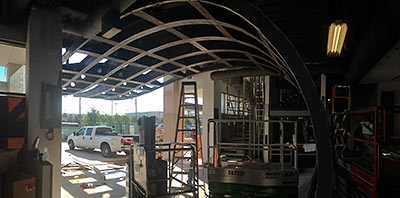
- Igloo Shows Off New 420,000 SF Warehouse and Distribution Center in Katy [Prime Property]
- Diane Von Furstenberg Signs On at River Oaks District [Houston Business Journal; previously on Swamplot]
- Maggie Rita’s at 1001 Fannin in the Tunnels Now Open [Eating Our Words; previously on Swamplot]
- Mayor Parker Proposes Policy To Improve Houston Streets [KUHF]
- Houston Traffic Hotspots: The Clear Lake Narrows [Hair Balls]
- 101-Year-Old Battleship Texas Has Sprung Its Fourth Leak Since September [Houston Chronicle; previously on Swamplot]
Photo of Vallone’s Steakhouse construction, I-10 at Gessner: Matthew Renfrow [previously on Swamplot]





While making streets downtown more bikable, could somebody consider paving Westheimer?
They were going to repave Westheimer but they diverted 25% of it’s fund to build some new cul-de-sacs in the prarie, you know to help with transportation.
Exactly. How about we work on making our roads more accessible to motorists first.
I’ve got an idea for our streets AND sidewalks…start requiring developers to bury powerlines.
Existing power lines are the domain and responsibility of the power company and developers can’t touch it. In the new developed communities power line ARE buried by default.
Totally agree about burying power lines. I’ve heard it’s massively expensive to do this but I don’t understand how digging a trench can be so blasted expensive, especially when one considers the expense, lost revenue, and trouble of having to repair downed lines after a storm.
Westheimer is the perfect example for why this new policy is needed. The old infrastructure manual — the document that governs streets in Houston — literally had no provision for a major thoroughfare within the right of way that exists on Lower Westheimer. Westheimer needs to be rebuilt — but it needs to be rebuilt in a way that makes sense. Right now it doesn’t work well for cars, it doesn’t work well for transit, it doesn’t work well for pedestrians, and it doesn’t work well for bikes, it doesn’t work well for businesses, and it doesn’t work well for residents. Tearing down all the buildings on the street to make it wider is not acceptable. Going to one lane in each direction with center turn lanes and wider sidewalks, and building some off-street shared parking in areas with lots of businesses, might actually be better for everyone (this is not a currently proposed plan — but it’s the kind of thing new guileless will allow.) That’s what Complete Streets is about — there’s no one-size-fits-all solution.
Developers do bury power lines in new developments. It would be unreasonable to expect buried power lines for a single lot development.
We’ve driven Carlos Mencia and his crappy Tex Mex underground. :)
@Ross & Commonsense,
Uh, no they don’t. I could name all of the new developments where power lines were not buried but that would take too long. However, I will give you one example in case you doubt me (5250 Brownway).
“Mayor Parker Proposes Policy To Improve Houston Streets ” [for pedestrians and cyclists, it turns out]
.
How about fixing them to make them accessible to CARS!? The potholes in this “first world” city have gotten out of hand.
Wow, they’re not starting that River Oaks District until July 2014? I thought with all this massive publicity they had already broken ground on at least part of the project. I like the renderings, it will be an elegant addition to the area and Target adjacent, could anything be more Houston?
In fairness to Houston and New Orleans as well, it’s the constant rain and soil consistency that cause the asphalt to come apart and wear so quickly. For example, streets in Los Angeles and San Deigo last forever (unless an earthquake or mudd slides take them out, you never see potholes, but I relation to Gulf Coast cities, they’re a real problem, especially when dealing with asphalt.
@Bama, that is a small development in the middle of an area with overhead lines. It’s not going to get buried lines. Build a 300 house subdivision on 30 acres, and the feed to the development might be overhead, but the homes will be fed underground. The one square block townhome development we used to live in in Midtown had underground feed to each house, but the feed to the development was off the overhead lines.